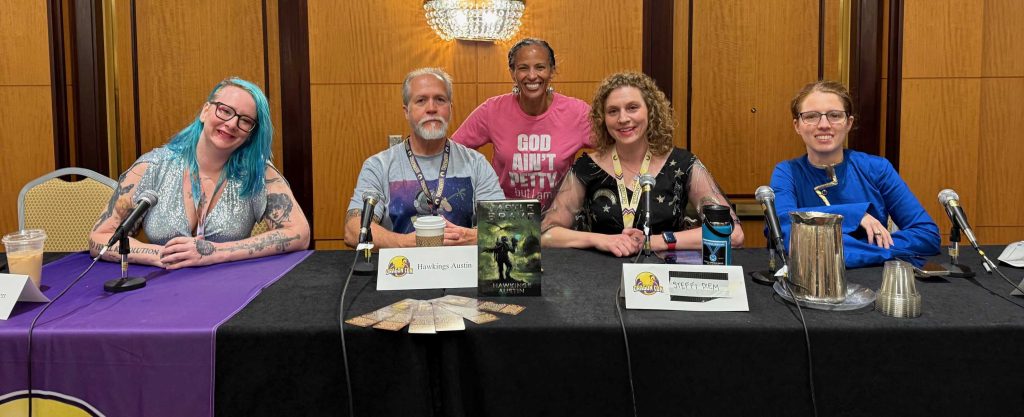
Experts say yes, but they wouldn’t recommend it. On Sunday at 11:30AM, the Science Track hosted “When Physics Gets Weird” in the Hilton Crystal Ballroom. Moderator Dr. Raychelle Burks—who opened by confessing her love of disco—was joined by astrophysicist Dr. Seven Rasmussen, radiation test engineer and author Hawkings Austin, fusion energy researcher Dr. Steffi Diem, and chemical engineer Liz Decolvenaere. Together, they delivered a whirlwind tour of physics at its strangest, from black holes to neutron stars to the mysteries of water.
Black holes, a favorite of pop culture, kicked off the discussion. Rasmussen described the Penrose process, in which matter dropped into a spinning black hole’s ergosphere can yield more energy than was put in—up to 24% more.
Based upon Burks raising the problems of black holes in popular TV, Austin joked about “turning St. Louis into a black hole,” noting that the gamma radiation produced by even a small black hole under the surface of the planet would be catastrophic. Diem discussed teaching a class on top of an open nuclear reactor while its running. There’s a blue glow caused by shrink off radiation from charge particles going faster than the speed of light. She also mentioned how astronauts saw these same blue glows in their eyes during Apollo missions.
The panel turned to the origins of elements. Rasmussen discussed the periodic table and how the big bang released only hydrogen and helium. Those elements formed the first stars, which produced heavier elements up to iron. She then notes that all elements heavier than iron come from catastrophic cosmic events like supernovae and neutron star collisions. She also mentioned that no one knows exactly how a supernova explodes, because we cannot properly model it. She challenged the audience, “If you figure it out, congrats on your Nobel Prize.”
Decolvenaere was not surprised that we cannot properly model a star blowing up because we cannot properly model water despite its importance to life. She noted how water moves is a weird result of lots of competing physics effects. Most things shrink when they freeze, but water expands as ice. Then there’s heavy water, where deuterium replaces hydrogen atoms, which makes it sweet. However, after an audience member asked if heavy water could be used as a sweetener, Decolvenaere noted that it would be impractical cost wise. Heavy water also behaves differently than water, so consuming too much of it would be unsafe.
Austin then switched the discussion from water to fire. He reminded the audience of the basic states of matter: liquid, solid, gas, and plasma. Diem pointed out that 99% of the visible universe is plasma, though it’s rare on Earth. Austin also noted that it’s a pain to work with plasma. Containing plasma, Diem added, is like “confining jelly with rubber bands.” The panel described glowing plasma experiments. When Burke asked if light sabers are possible, Diem noted that “if you have a high-speed gas and you hit it with a high voltage and electrified it with tens of thousands of volts you could, but I wouldn’t do it.”
For another weird physics topic, Rasmussen described “nuclear pasta,” the dense, layered matter inside neutron stars, with structures nicknamed gnocchi, spaghetti, and lasagna. These bizarre states exist only under pressures billions of times stronger than Earth’s gravity.
The panelists began taking questions and one person asked what happens when two neutron stars collide? Rasmussen replied that the collision leads to the highest temperatures and extreme energies in the whole universe. It produces gravitational waves and creates the heaviest elements in the universe. “Everything heavier than iron on this planet,” Rasmussen said, “came from the collisions of dead zombie (neutron) stars.”
This led to a question of whether new forms of matter remain undiscovered? Austin suggested it’s possible because we don’t understand super-hot or super high-pressure matter. Solar conditions are still well out of our range. Burke closed out the session asking the audience if the panelists presented weird enough physics examples for their taste. To satisfy a challenging audience member, Rasmussen recalled that in the 1980s, 3M accidentally created the only real force field ever produced. There are scientific papers on it. No one ever discussed how it happened nor ever replicated it.
